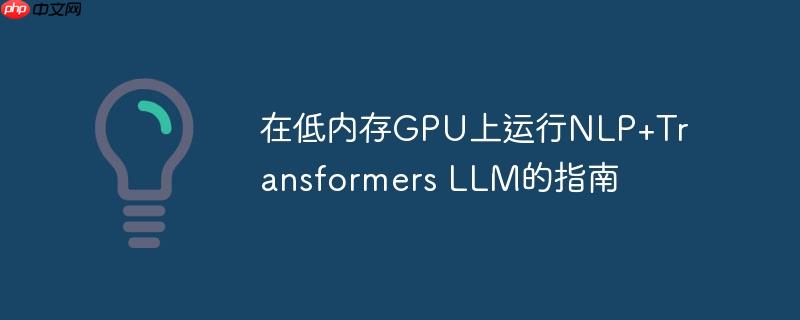
在低内存GPU上运行大型语言模型(LLM)时遇到的资源限制问题,可以使用模型量化和特定优化的AutoAWQ库来解决。本文档旨在演示如何加载和运行Intel的neural-chat-7B-v3-1模型,即使在资源受限的环境中也能实现。通过详细的代码示例和步骤,帮助您有效地利用GPU资源,避免常见的内存溢出错误。
模型量化:降低内存占用
当尝试在资源有限的GPU上运行大型语言模型时,内存溢出是一个常见的问题。模型量化是一种有效的解决方案,它通过降低模型参数的精度来减少内存占用。例如,将模型参数从32位浮点数(float32)转换为8位整数(int8)或更低的精度,可以显著减少模型的内存占用,同时保持相对较好的性能。
Hugging Face的transformers库提供了模型量化的支持。同时,社区也提供了预量化的模型版本,可以直接使用。
使用AutoAWQ加速推理
AutoAWQ是一个专门为加速量化模型推理而设计的库。它提供了优化的内核,可以在GPU上高效地运行量化模型。TheBloke 在Hugging Face上提供了neural-chat-7B-v3-1的量化版本,可以与AutoAWQ一起使用。
以下是使用AutoAWQ加载和运行neural-chat-7B-v3-1模型的步骤:
- 安装必要的库
首先,需要安装transformers、accelerate和autoawq库。由于Colab环境的CUDA版本可能较低,需要安装特定版本的autoawq。
!pip install -q transformers accelerate !pip install -q -U https://github.com/casper-hansen/AutoAWQ/releases/download/v0.1.6/autoawq-0.1.6+cu118-cp310-cp310-linux_x86_64.whl
- 加载量化模型和tokenizer
使用AutoAWQForCausalLM.from_quantized方法加载量化模型。确保使用TheBloke提供的量化模型名称。
import torch from awq import AutoAWQForCausalLM from transformers import AutoTokenizer model_name = 'TheBloke/neural-chat-7B-v3-1-AWQ' model = AutoAWQForCausalLM.from_quantized(model_name) tokenizer = AutoTokenizer.from_pretrained(model_name)
- 编写生成响应的函数
创建一个函数,该函数接收系统输入和用户输入,并生成模型的响应。关键步骤是将输入张量移动到GPU上,通过调用.cuda()方法实现。
def generate_response(system_input, user_input): # Format the input using the provided template prompt = f"### System:n{system_input}n### User:n{user_input}n### Assistant:n" # Tokenize and encode the prompt, move to GPU inputs = tokenizer.encode(prompt, return_tensors="pt", add_special_tokens=False).cuda() # Generate a response outputs = model.generate(inputs, max_length=1000, num_return_sequences=1) response = tokenizer.decode(outputs[0], skip_special_tokens=True) # Extract only the assistant's response return response.split("### Assistant:n")[-1]
- 使用示例
使用示例系统输入和用户输入来测试模型。
# Example usage system_input = "You are a math expert assistant. Your mission is to help users understand and solve various math problems. You should provide step-by-step solutions, explain reasonings and give the correct answer." user_input = "calculate 100 + 520 + 60" response = generate_response(system_input, user_input) print(response)
注意事项
- CUDA版本兼容性: 确保安装的autoawq版本与您的CUDA版本兼容。如果遇到问题,请尝试安装不同版本的autoawq。
- GPU利用率: 监控GPU利用率,确保模型正在GPU上运行。可以使用torch.cuda.is_available()检查GPU是否可用。
- 内存管理: 即使使用了量化,仍然需要注意内存管理。避免一次性加载过大的数据,可以尝试分批处理。
- 模型选择: 根据您的需求选择合适的量化模型。不同的量化方法和精度会对性能产生影响。
总结
通过模型量化和使用AutoAWQ库,可以在低内存GPU上有效地运行大型语言模型。本文档提供了一个详细的指南,演示了如何加载和运行neural-chat-7B-v3-1模型。通过遵循这些步骤,您可以克服资源限制,并利用LLM的强大功能。记住,选择合适的量化方法、确保CUDA版本兼容以及有效管理内存是成功运行LLM的关键。





评论(已关闭)
评论已关闭